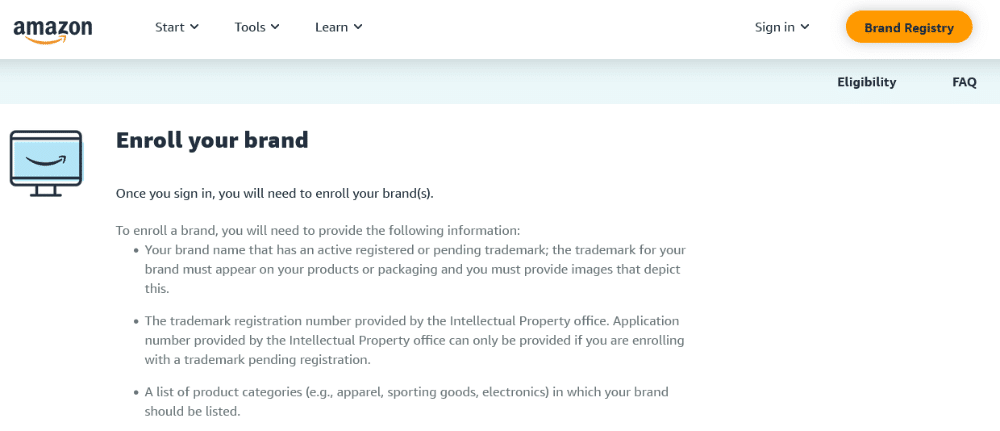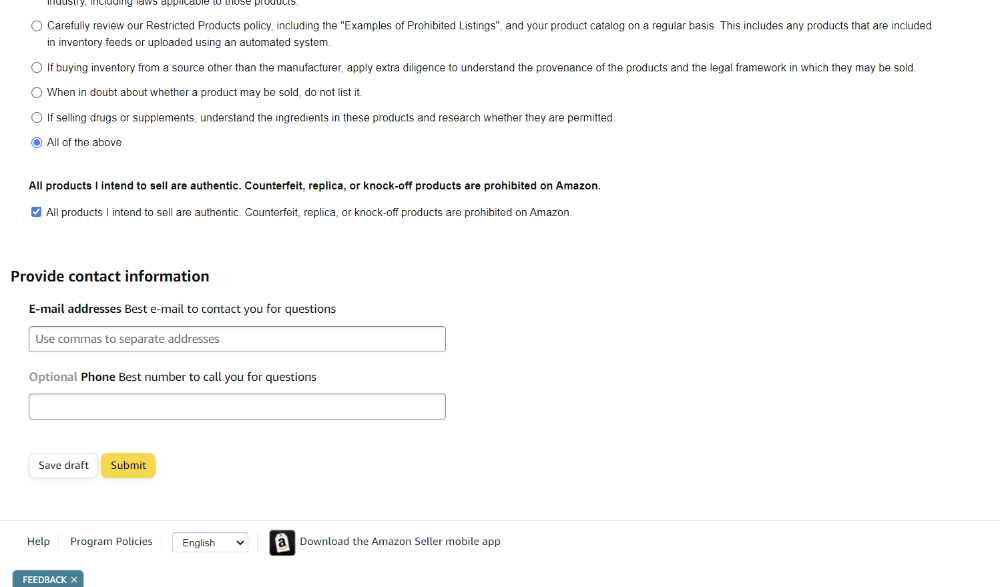📑Table of Contents:
- A Step-by-Step Guide to Quick Brand Approval on Amazon
- Selling Application for Fine Jewelry on Amazon
- Post-Approval Expectations and Maintenance!
- Benefits of Compliance
- Expert Tips for a Smooth Brand Approval Process
- 1. Craft a Compelling Brand Story
- 2. Optimize Product Listings
- 3. Leverage Amazon Brand Analytics
- 4. Monitor Competitor Activity
- 5. Invest in Marketing and Advertising
- 6. Stay Informed About Policy Changes
- 7. Engage with Customer Reviews
- 8. Utilize Amazon Brand Registry
- 9. Consider Amazon FBA (Fulfillment by Amazon)
- 10. Seek Legal Advice
- Understanding Your Role
- Responsibilities When Listing Products
- Consequences of Non-Compliance
- Best Practices for Compliance
- Authenticity is Key
- An Example of How to Approve a Brand in Amazon Seller Central
Last updated on October 18th, 2023 at 01:44 pm
Are you eager to get your brand quickly approved on Amazon? Look no further! In this guide, we’ll show you the steps to streamline the process and ensure compliance with Amazon’s Anti-Counterfeit Policy. Let’s dive right in!
A Step-by-Step Guide to Quick Brand Approval on Amazon
Now that we’ve covered the basics and best practices for Amazon brand approval let’s break down the process into actionable steps to expedite your journey.

Step 1: Gather Essential Information
Before diving into the brand approval process, gather all the necessary information about your business and products. This includes details about your company, product catalog, and any relevant documentation.
Step 2: Register for an Amazon Seller Account
If you don’t already have one, sign up for an Amazon seller account. Choose between an Individual or Professional account based on your sales volume and business needs.
Step 3: Apply for Brand Approval
Once you’re logged into your seller account, navigate to the Brand Registry section. There, you can initiate the brand approval process by providing information about your brand, including its name, logo, and a list of products associated with it.
Step 4: Ensure Product Authenticity
As previously mentioned, ensure that all the products you intend to sell are authentic and not counterfeit, replicas, or knock-offs. Amazon takes counterfeits seriously and actively works to prevent them from entering its marketplace.
Step 5: Provide Detailed Product Information
During the brand approval process, you’ll need to provide detailed product information, including product images, descriptions, UPC or EAN codes, and any other relevant data. Ensure that this information is accurate and up-to-date.
Step 6: Maintain Compliance
Even after obtaining brand approval, it’s crucial to maintain compliance with Amazon’s policies. Continue to monitor your product listings and make sure they adhere to Amazon’s guidelines. Regularly review your product catalog to ensure that no prohibited items slip through the cracks.
Step 7: Seek Professional Help if Needed
If you find the brand approval process overwhelming or if you’re unsure about specific aspects of compliance, consider seeking professional assistance. There are consultants and agencies experienced in navigating Amazon’s policies and procedures who can provide valuable guidance.
Selling Application for Fine Jewelry on Amazon
Fine Jewelry are high-end items with high prices. You can definitely increase revenue and profit. However, before start selling jewelry in Amazon, you need to follow certain rules.
Approval IS NOT difficult, you just need to agree on Amazon’s terms!
Still, they will check your account and history. As most sellers are aware, Amazon requires approval for most categories and brands.
When you opt to become a seller in the Fine Jewelry category on Amazon, you’re essentially seeking authorization to list and sell high-quality, genuine jewelry items. This is a specialized category, and Amazon exercises utmost diligence to ensure the authenticity and quality of products listed under it.

Key Contact Information
- Email Address: This should be the primary email where Amazon can reach out for any queries or clarifications regarding your application or products.
- Optional Phone Number: If Amazon needs to reach out for an immediate response or discussion, provide the best number where you can be contacted.
- Make sure the emails and phone numbers are reachable. Amazon representatives may contact you. They usually do so via email. Rarely, they would give you a call. Calls are happening only when there is a risk of the account being deactivated or suspended.
Compliance with Selling Conditions
- Only brand-new jewelry items are to be listed for sale.
- It’s crucial that all products be authentic. Amazon has a strict policy against listing counterfeit, replica, or imitation products.
- Sellers must abstain from selling specific items such as glass-filled rubies and clarity-enhanced white diamonds.
- There’s a pricing ceiling for jewelry items, which is set at $125,000.
- If you’re listing white diamond jewelry containing:
- A single stone of 0.75 carats or more (for rings and pendants), or
- For stones that exceed a total of 1.0 carats (for stud earrings), you need to provide a certificate of authenticity from recognized institutions like GIA, IGI, AGS, or GCALGem Certification and Assurance Lab.
- Jewelry crafted from precious metals, adorned with precious gemstones or authentic pearls, should be classified under the Fine Jewelry category.
- Sellers must strictly abide by Amazon’s Fine Jewelry Terms and Conditions.
Quality Assurance Review
- As a part of the application process, you’re expected to submit sample items for Amazon’s Jewelry Quality Assurance review.
- It’s imperative that all samples conform to Amazon’s distinction between Fine and Fashion Jewelry.
- The process of reviewing your application can span from 6 to 10 weeks. This duration encompasses the time required for the submission, testing, and evaluation of the provided sample items.
- Upon submission, Amazon will furnish further directives about how the sample items will be tested.
It’s vital to ensure that all the requirements are diligently followed, as this not only accelerates the approval process but also establishes trust and credibility with potential customers on the platform.
Post-Approval Expectations and Maintenance!
Once you receive approval to sell in the Fine Jewelry category, your journey as a seller doesn’t end. To maintain your seller status and ensure a positive customer experience:
- Consistent Quality: Always ensure that the products you list maintain the same quality as your sample items. Regular audits of your inventory can be helpful.
- Timely Updates: If there are any changes in your product lineup, certifications, or supply chain, promptly update this information on Amazon.
- Customer Service: Quickly address any customer queries or concerns. This not only helps in building trust but also positively affects your seller rating on the platform.
- Feedback Monitoring: Pay attention to customer feedback. Positive reviews can boost sales, while negative feedback can provide insights into areas of improvement.
- Adherence to Amazon’s Policies: Continually review Amazon’s Fine Jewelry selling policies to ensure that you are always in compliance. This can protect you from potential listing removals or account suspensions.
- Inventory Management: Ensure that your inventory levels are always updated. This helps in avoiding situations where you cannot fulfill an order due to stock unavailability.
- Regular Training: If you have a team managing your Amazon listings, ensure they are regularly trained and updated on Amazon’s policies and quality requirements.
- Engagement: Participate in any Amazon-led initiatives or training programs designed for fine jewelry sellers. This can provide valuable insights into market trends and best practices.
Benefits of Compliance
By adhering to Amazon’s guidelines:
- Build Trust: Customers are more likely to purchase from sellers who consistently provide authentic and high-quality products.
- Higher Visibility: Adhering to guidelines can lead to better search rankings and visibility on the platform.
- Reduced Returns: By maintaining quality and authenticity, you can potentially reduce return rates.
- Increase in Sales: A consistent track record of compliance and positive feedback can drive more customers to your listings and result in increased sales.
Becoming a seller in the Fine Jewelry category on Amazon is a significant step that requires careful preparation, diligence, and ongoing commitment. By understanding and following the guidelines, you can establish a successful and reputable Fine Jewelry business on one of the world’s largest e-commerce platforms.
Expert Tips for a Smooth Brand Approval Process
In addition to the steps outlined above, here are some expert tips to further streamline the brand approval process on Amazon:
1. Craft a Compelling Brand Story
When submitting your brand for approval, make sure to include a compelling brand story that highlights your unique selling points. This not only helps your application stand out but also adds a human touch to your brand, making it more appealing to customers.
2. Optimize Product Listings
To enhance your chances of brand approval, ensure that your product listings are optimized. Use high-quality images, detailed descriptions, and relevant keywords to improve visibility and attract potential customers.
3. Leverage Amazon Brand Analytics
Amazon offers Brand Analytics, a valuable tool that provides insights into customer behavior, keyword research, and competitor analysis. Utilize this tool to refine your product listings and marketing strategies.
4. Monitor Competitor Activity
Keep a close eye on your competitors, especially those within your niche. Understanding their product offerings and pricing strategies can help you position your brand more effectively.
5. Invest in Marketing and Advertising
Consider running Amazon advertising campaigns to increase brand visibility and drive sales. Sponsored Products and Sponsored Brands can be effective tools for reaching a wider audience.
6. Stay Informed About Policy Changes
Amazon’s policies and guidelines can change over time. Stay informed by regularly checking Amazon’s Seller Central for updates. Failing to adapt to policy changes can result in compliance issues.
7. Engage with Customer Reviews
Engage with customer reviews and address any issues promptly. Positive customer feedback and strong seller ratings can boost your brand’s reputation and credibility.
8. Utilize Amazon Brand Registry
Enrolling in the Amazon Brand Registry provides additional protection for your brand and listings. It allows you to report intellectual property violations and gain more control over your product listings.
9. Consider Amazon FBA (Fulfillment by Amazon)
Amazon FBA can simplify order fulfillment, shipping, and customer service, allowing you to focus on growing your brand. It also makes your products eligible for Amazon Prime, which can attract more customers.
10. Seek Legal Advice
If you encounter legal or intellectual property issues during the brand approval process, it’s advisable to consult with an attorney who specializes in e-commerce and intellectual property law. They can guide you in protecting your brand and resolving disputes.
Related post: How to Sell in Amazon Canada and Mexico from Amazon Seller Central USA!
Understanding Your Role
First and foremost, it’s essential to clarify your role in the Amazon marketplace. Are you a reseller/distributor, a manufacturer, or both? Your role affects your responsibilities and how you navigate the brand approval process.
Responsibilities When Listing Products
When listing products on Amazon, one fundamental principle should guide you: you are responsible for every product you sell. Don’t assume that Amazon will remove prohibited products – you must ensure compliance with the law and Amazon policies.
Consequences of Non-Compliance
Selling illegal or policy-violating products can lead to severe consequences. These include the removal of your product listings, the loss of eligibility to sell in specific categories, or, in extreme cases, the suspension of your entire seller account.

Best Practices for Compliance
To ensure compliance with Amazon’s policies, here are some best practices to follow:
- Assign Responsibility: Designate an employee with expertise in your products and industry to review each item before listing.
- Regular Reviews: Periodically review Amazon’s Restricted Products policy and your product catalog. Be vigilant in spotting prohibited items.
- Verify Provenance: If sourcing products outside the manufacturer, thoroughly understand their origin and legal status.
- When in Doubt, Don’t List: If you’re unsure about a product’s eligibility, refrain from listing it until you’ve clarified its status.
- Research Ingredients: If selling drugs or supplements, research their ingredients to ensure they meet Amazon’s requirements.
Authenticity is Key
Remember, counterfeit, replica, or knock-off products are strictly prohibited on Amazon. Ensure that all products you intend to sell are authentic to avoid any issues during the brand approval process.
By adhering to these best practices and understanding your responsibilities, you’ll be well-prepared to navigate Amazon’s brand approval process efficiently and avoid compliance pitfalls.
An Example of How to Approve a Brand in Amazon Seller Central
This is an example of a brand that has not been registered and “locked” by another company or account in Amazon. Amazon does a quick interview to educate and inform sellers of the consequences if they do not follow the Amazon terms and conditions. In short, sellers are told that if they sell fake products, listings and/or accounts can be suspended.
This is the example of questions that Amazon will ask a seller:
Are you a reseller/distributor, a manufacturer, or both for the products you want to list?
- Reseller/Distributor
- Manufacturer
- Both

Which of the following statements describes your responsibility when listing products on Amazon:
- Once I’m approved to sell in a category, I can sell any product without needing to vet the product.
- I don’t need to review every product I sell on Amazon because I’m sure Amazon will just remove the product if it isn’t allowed.
- If another seller is already selling the product on Amazon, then I can assume it is allowed to be sold on Amazon.
- I’m responsible for all products I sell on Amazon and for understanding whether they violate the law or are otherwise restricted from sale on Amazon.
If you list products for sale on Amazon that are illegal or otherwise in violation of Amazon policies, the following consequences could result (please select the best answer):
- Your offer for the products in question may be removed.
- Your eligibility to sell in a particular category may be removed.
- Your entire seller account may be blocked (in the case of more severe offenses, such as selling an illegal supplement).
- All of the above.
Which of the following represents a best practice when selling on Amazon to ensure compliance with our policies:
- Assign one or more employees to be responsible for reviewing each product you plan to sell. This employee should have deep and up-to-date knowledge of the products as well as the industry, including laws applicable to those products.
- Carefully review our Restricted Products policy, including the “Examples of Prohibited Listings”, and your product catalog on a regular basis. This includes any products that are included in inventory feeds or uploaded using an automated system.
- If buying inventory from a source other than the manufacturer, apply extra diligence to understand the provenance of the products and the legal framework in which they may be sold.
- When in doubt about whether a product may be sold, do not list it.
- If selling drugs or supplements, understand the ingredients in these products and research whether they are permitted.
- All of the above.
All products I intend to sell are authentic. Counterfeit, replica, or knock-off products are prohibited on Amazon.
- All products I intend to sell are authentic. Counterfeit, replica, or knock-off products are prohibited on Amazon.

Conclusion
Getting your brand approved on Amazon is a pivotal step in establishing your presence on one of the world’s largest e-commerce platforms. By understanding your responsibilities, adhering to best practices, and following the steps outlined in this guide, you can significantly expedite the brand approval process.
Remember, authenticity is key, and compliance with Amazon’s policies is non-negotiable. By committing to these principles and staying vigilant, you can build a successful and sustainable business on Amazon while avoiding the potential pitfalls of non-compliance.
So, take the first step today, gather your information, and embark on your journey to quickly approve your brand on Amazon. Your success on this thriving platform awaits! Learn more.





